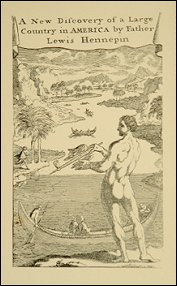 He sailed the Mississippi...
He sailed the Mississippi...or did he?
Father Louis Hennepin was a Franciscan Friar who accompanied La Salle on his Western expedition of 1679 to reach the Gulf of Mexico from Canada, via the Mississippi River. After the trip Hennepin wrote his famous “A New Discovery of a vast Country in America”, originally published in French in 1697 and in English in 1698.
Hennepin tells of his travels with La Salle on the Griffon, the first ship on the Great Lakes, to Green Bay and across the Mississippi by the Illinois route. From there Hennepin was sent with an expedition, led by Michel Aco, which was the first to explore the upper Mississippi valley. They ascended the river to Minnesota, where they were captured by the Issati Sioux. The party was eventually rescued by Duluth who insisted on their release, though some claim that Hennepin’s constant complaints and lectures had already become so tedious to the Sioux, that they were happy to be rid of him.
Unfortunately, Hennepin was a notorious liar. In his accounts he claims close association with La Salle, but La Salle thought little of Hennepin, even warning his colleagues about Hennepin’s habit of exaggeration. Prompted by his efforts at political maneuvering and his own penchant for tellings fibs, Hennepin’s accounts of his journeys along the Mississippi vary from only slightly overblown to outright plagiarism. He claims to have traversed both the upper and the lower Mississippi all the way down to the Gulf of Mexico, but the time between his departure from the country of the Illinois and his capture by the Issati is not sufficient for such a long canoe voyage.
Despite the falsehoods about some aspects of the expeditions described in his narrative, Hennepin’s book became a standard text on North America. It should also be said that he was an acute observer, and his books contain detailed and accurate descriptions of the characteristics, arts, and customs of the Indians. He made careful note of the wildlife they encountered, and his descriptions of natural history convey not only a physical description of the animal in question, but Hennepin’s own personal reaction to the creatures as well. His is the first written description, complete with illustration, of Niagara Falls and his examination of every facet of American Indian culture is a gold mine of information.
In 1903 Reuben Gold Thwaites edited a new edition of “A New Discovery of a Vast Country in America”, with facsimiles of the original title-pages, maps and illustrations, and a new introduction, notes and index.
We have a copy of the 1903 edition up for auction this week -click our Auction link in the right-hand column.
We're hard at work on our new May-June catalog, which will be mailed in a few weeks -if you're not on our mailing list and would like a copy, please let us know.
We're also hard at work (or hardly at work) on the new edition of A Grave Affair -Books on Gravestones & Memorial Arts -again, let us know if you would like a copy of the catalog when it is ready.

No comments:
Post a Comment